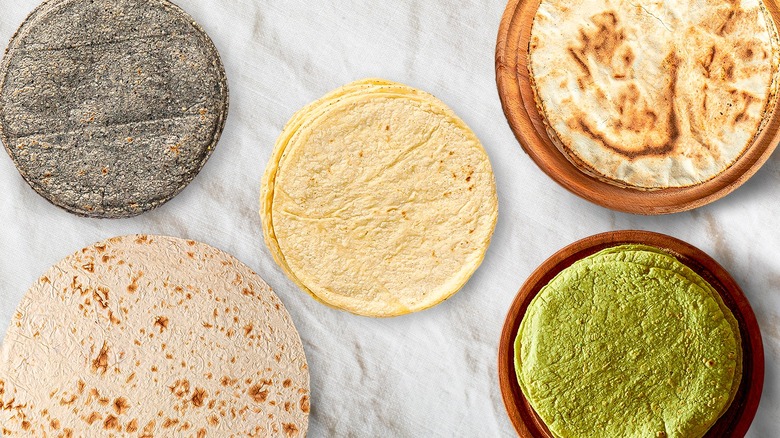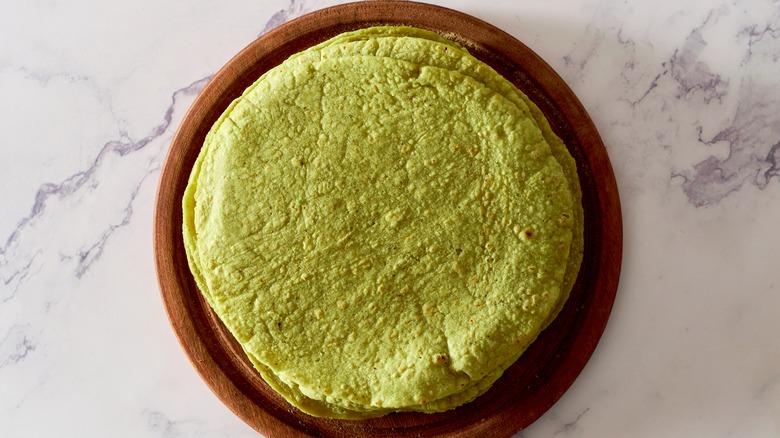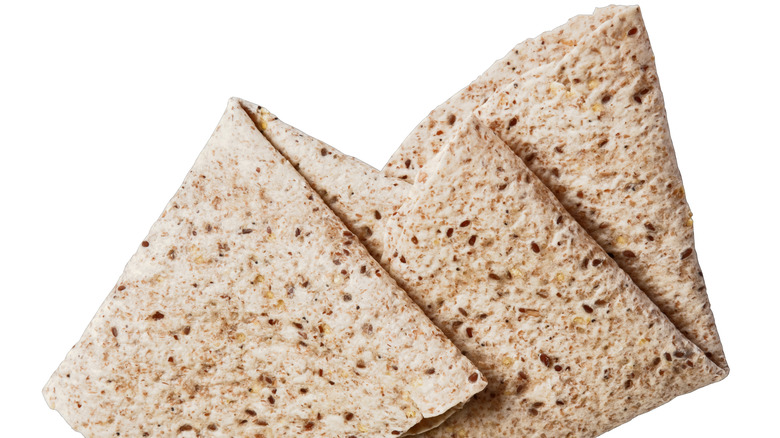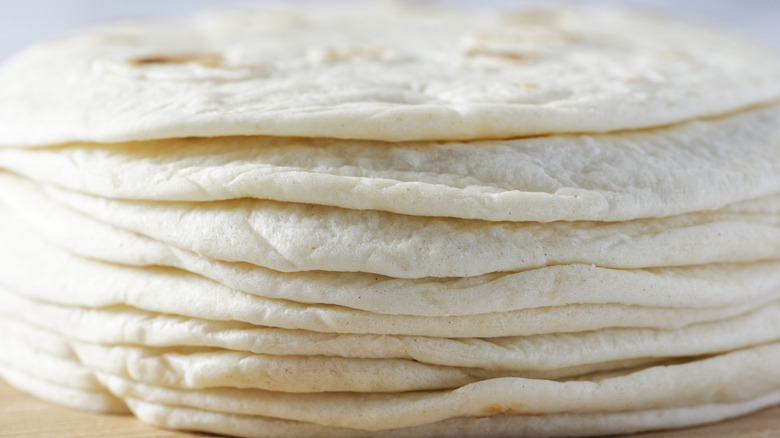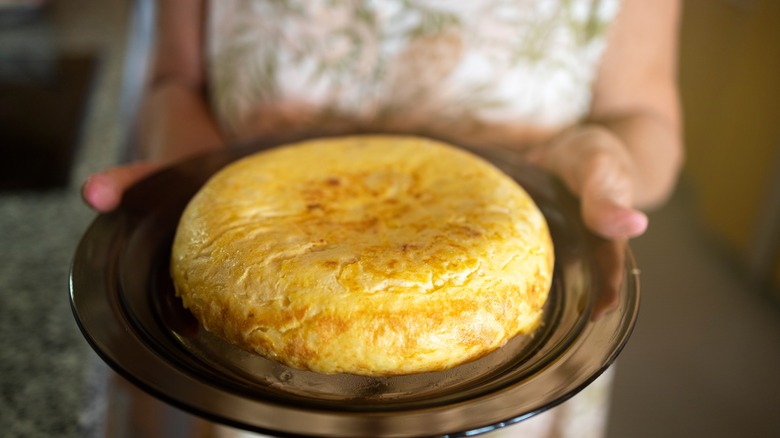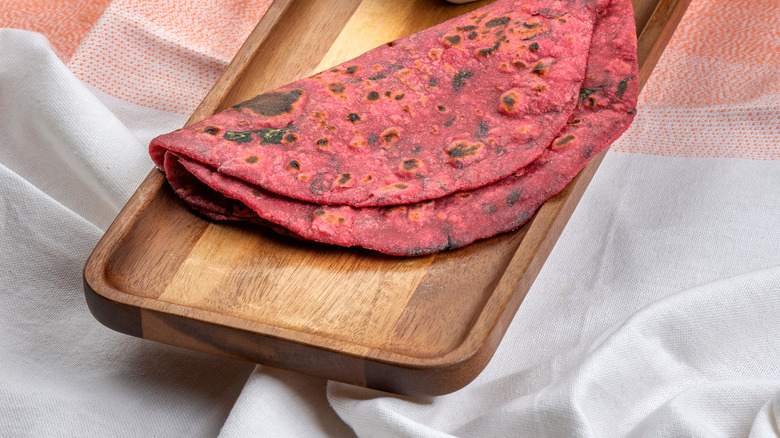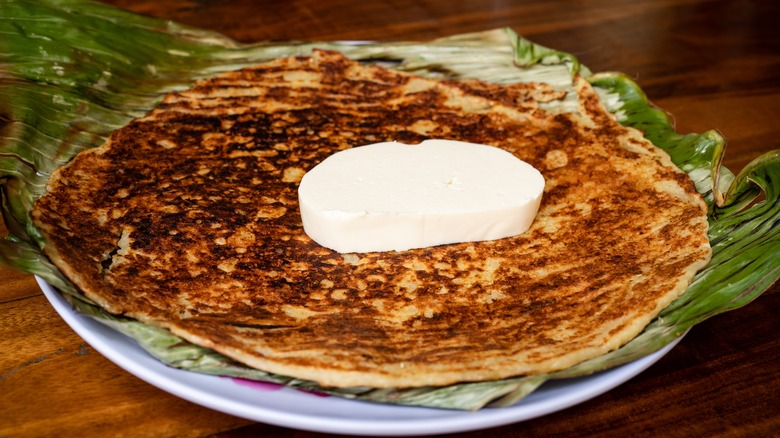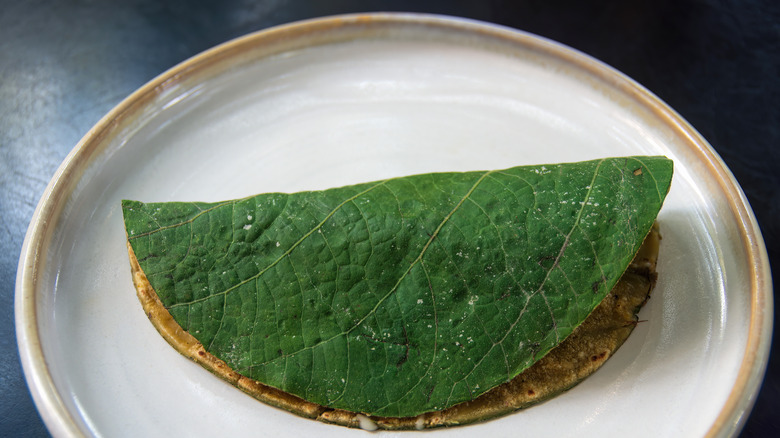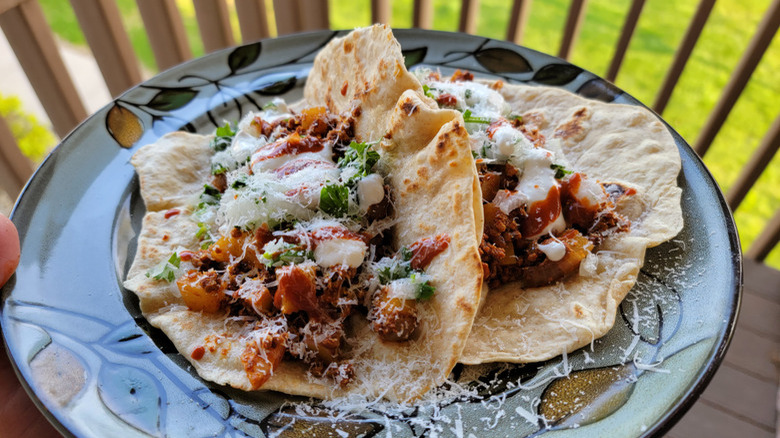11 Types Of Tortillas, Explained
Tortillas are a staple component of many dishes, including tacos, fajitas, enchiladas, and more. But, that doesn't mean that you can swap one tortilla for another all willy-nilly. Rather, each type of tortilla, whether it's from your local grocery store or ethnic grocer or made in your own home kitchen, has a special utility that makes it better suited for some applications and fillings and not others.
In order to gain a better understanding and appreciation for the scope of the various tortilla varieties that you might see on shelves or on restaurant menus, we consulted two experts: chef Erasmo "Ras" Casiano of Lucina Eatery & Bar and Xiquita Restaurant & Bar, and chef Carlos Gaytán. They not only provided insight about the difference between how these tortilla types are made, but also where to use them to reap the fullest potential of their flavor and texture. We guarantee that it will make you think twice about settling for a pack of ho-hum yellow corn tortillas for everything.
Yellow corn tortillas
If you've ever ordered a taco from a local taqueria, chances are that it was served on a yellow corn tortilla. These tortillas are like the workhorse of the tortilla world. It's easy to distinguish them by their yellow hue, because they're made with — you guessed it — yellow corn. But, there are also structural differences that set it apart from other types of tortillas. For one, the yellow tortilla is very thin and brittle; it's less pliable than a white corn tortilla or one made with flour. The corn also has a mealy and coarse texture to it, which alters the mouthfeel of the tortilla.
"Yellow corn tortillas are excellent for frying, as they achieve a crispy texture without absorbing excessive oil, making them perfect for dishes like tostadas or chips," explains chef Carlos Gaytán. Gaytán shares that the subtle sweet flavor of the corn makes it a perfect topping for a variety of different tacos, especially ones that feature meats and vegetables.
Blue corn tortillas
The blue corn tortilla is beautiful. It can provide a lovely color contrast to milky white Oaxaca cheese, as well as brightly colored peppers and onions. But, anyone who has worked with blue corn tortillas knows that these are not just a pretty face. They are actually very structurally sound and can be used in a variety of different recipes. "They have a slightly nuttier taste and a denser texture, making them ideal for traditional dishes like tacos or sopes, where the tortilla needs to hold up to hearty fillings," explains Carlos Gaytán.
Gaytán also notes that blue corn tortillas carry a ton of nutritional benefits, in conjunction with a "robust flavor." This is because the blue color is created by a pigment called anthocyanin; it's the same stuff that makes blueberries blue. There are some studies that indicate that the pigment may aid in brain health and ward off diseases like cancer and diabetes — but there have been no concrete linkages between the health benefits and eating blue corn tortillas, specifically. That being said, you can always eat an extra taco ... just in case.
White corn tortillas
If you love the nutty flavor of a corn tortilla but don't want to try a mealy yellow corn one, your next best bet is going to be white corn tortillas. Chef Carlos Gaytán shares that these white corn tortillas are a very important part of Mexican cuisine, and the culture at large. "In Mexico, white corn is also used to make masa for tamales and pozole, a testament to its central role in the cuisine," he says. He shares that white corn tortillas are quite versatile and can be used as a vector for meats, like barbacoa, and as a wrap for enchiladas. You'll also often see them as a side dish for punchy, flavorful dishes including moles or stews.
Like other corn tortillas, white corn tortillas are made using masa harina, water, and salt. Since they're made with white corn, rather than blue or yellow corn, they tend to have a more impartial flavor and a pliable texture. So, feel free to fold them up into homemade black bean flautas or dip them into a thick sauce as a side dish.
Nopal tortillas
Nopal tortillas are bound to catch you off-guard the second you see them. The key ingredient that gives nopal tortillas their distinct color and texture is nopal: a type of cactus. This variety, otherwise called the prickly pear cactus, is found a range of Mexican dishes. When added to tortillas, Carlos Gaytán notes that the nopal adds a "subtle tang," which pairs well with especially rich ingredients like guacamole.
The base of the nopal tortilla varies; it's not just a piece of cactus griddled until it's pliable. You'll see some recipes made with white flour, as well as others made with corn flour. You'll also often find recipes that call for cilantro to be mixed with the dough, as it adds a sharp flavor and helps accentuate the green color of the tortilla. To prepare, the cooked nopals are added to a food processor or a blender with the herbs. Then, the puree is mixed into the standard tortilla recipe.
Amaranth tortillas
Amaranth tortillas are ideal for anyone who wants to get a jump start on their recommended daily intake of fiber. Carlos Gaytán explains that the grain helps add an extra crunch to the tortilla, which makes it a welcomed addition for recipes where the ingredients tend to otherwise be soft. Amaranth tortillas can be made a variety of ways. One of them includes starting with amaranth flour, along with the usual suspects: water and salt. These tortillas will have an all-around nutty flavor, but they won't be as tasty as a tortilla that's studded with amaranth seeds.
Some amaranth tortillas are made with other grains and flours, including brown rice, millet, and quinoa, to give them a little bit more of a pliable texture. Depending on the grains used, some amaranth tortillas may be gluten-free — but always check the label before enjoying.
Flour tortillas
There are two tortillas you may be very well familiar with: corn tortillas and flour tortillas. Flour tortillas are definitely the more pliable of the two — and you can thank the gluten in them for that. But, that's not the only reason why flour tortillas are the perfect vessel for a variety of fillings, including carne asada tacos and quesadillas (per Carlos Gaytán's suggestion). "The wheat flour is mixed with lard to create a texture that is both sturdy and tender, perfect for wrapping hearty fillings without breaking," he says.
But, if you are eating an animal product-free diet, fear not. There are some substitutions that you can make for lard. Our easy flour tortillas recipe features a neutral oil, like avocado or canola, to help lubricate the flour and ensure that this tortilla is soft. However, some folks will argue that the best fat to use in homemade tortillas is something that's solid at room temperature — which means you may be better off turning to vegetable shortening if lard isn't in the cards. You can also ensure fluffy homemade flour tortillas by working with a flour with a gluten content that ranges between 10% and 12% and working on a griddle that's not too hot, nor too cold.
Spanish tortillas
Spanish tortillas are not the same as corn or flour tortillas — and we're guaranteed that they don't look anything like the other tortilla varieties on this list. This dish actually resembles more of a frittata; the only thing it actually has in common with the other tortillas is that it's shaped into a round disc. There's not even any actual tortilla (corn or flour) involved. Instead, the base is made with potatoes and onions and then covered in an egg mixture. Spanish tortillas are best served as-is, or you might consider serving them hot or cold, or spicing things up by topping them with a smoky romesco sauce.
That's not to say you can't find a creative way to integrate regular tortillas into a Spanish tortilla recipe. Consider serving your Spanish tortillas with a side of corn tortillas; you could even try wrapping up a slice inside of a warmed one for a breakfast burrito-like effect.
Beetroot tortillas
Meet the Barbie of the tortilla world. There's just something so attractive and remarkable about a beetroot tortilla. The recipe starts with a pink beetroot, along with corn flour, water, and salt. Some folks will also make these with a flour base. From there, the grated beetroot can be easily mixed into the batter, where it quickly starts to infuse everything with a delectable and unique pink hue. While some recipes will stick to this method, you could also cook and puree the beets ahead of time, as it will give you a batter with less noticeable chunks in it.
The options for serving this type of tortilla are seemingly endless, but it's best to use a color wheel to select the most visually appealing pairings. For example, we'd recommend using warmed beetroot tortillas as a base for your fajitas recipe. The pink hue will stand in stark contrast to grilled green peppers and white onions, as well as a dollop of sour cream. Moreover, the beet root doesn't impart a ton of flavor — it's more for the color novelty than anything.
Güirila
You'd be remiss not to try güirila on a trip to Nicaragua. The batter for these tortillas differs from other types because it's made with young, sweet corn. It's believed that the translation for this dish, which is often served with fresh cheese and sour cream, is "fragrant and tasty bread." And fragrant and tasty bread it is.
Besides this topping duo, the güirila is also set apart from the other types of tortillas on this list because it doesn't follow the nesquizado (nixtamalization) process. Nixtamalization essentially involves cooking down the corn with an alkaline substance, like ash, to make it easier to digest and to enhance its nutritional properties. While this process is essential for making corn tortillas, güirilas are made instead by removing the husk from a fresh corn cob before pureeing it down. As a result, güirila are not shelf-stable, so your best options for getting your hands on them is to either pay Nicaragua a visit or try to whip up a batch of them at home.
Hoja santa tortillas
The hojo santa tortilla looks like it walked straight out of nature — because it kind of did. The key to this recipe is the leaf of the "sacred pepper plant" — which is a common ingredient in southern Mexican dishes. Some describe the leaf's flavor as having soft notes of eucalyptus, while others find notes of peppercorn and allspice. Regardless, its unique profile makes it a powerful addition to a comparatively flavorless tortilla.
Although it might seem like a challenge to stitch the leaf together with a tortilla, chef Erasmo "Ras" Casiano walked us through the process. "Start by removing the rib from the hoja santa leaf and placing it onto your freshly pressed tortilla. Gently press the leaf into the masa using your tortilla press, then transfer it to your comal or griddle," he says. "The anise-y aroma and flavor this adds to your dish are simply divine." Try pairing this tortilla with refried beans, or stick with a simple vegetable filling to let the leaf's strong flavor do the work.
Pan árabe
You may be familiar with tacos árabes, a type of taco that melds Middle Eastern cooking methods with Mexican cuisine. But, we're here to focus on the base of these tacos, which may be some of the best tortillas out there. Also known as Pueblan pita bread, this tortilla offers a soft, wholesome mouthfeel with a little more of a rustic, rough-around-the-edges look to it.
The best part about this tortilla is that you won't even need a press to make them at home. They're often made with yeast, which helps give them a characteristic puff, along with water and flour. Then, the dough needs to be rested so that the yeast can work its magic. The only thing left to do is to flatten the dough balls on a hot griddle before cooking them into an approachable wrapping for your spicy, meaty filling.
Static Media owns and operates Tasting Table and The Takeout.
